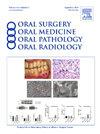人乳头瘤病毒基因型在头颈癌中的分布与人类免疫缺陷病毒状态的关系
IF 1.9
3区 医学
Q2 DENTISTRY, ORAL SURGERY & MEDICINE
Oral Surgery Oral Medicine Oral Pathology Oral Radiology
Pub Date : 2025-07-21
DOI:10.1016/j.oooo.2025.04.077
引用次数: 0
摘要
在过去的二十年中,头颈部肿瘤学最具变革性的事件之一是认识到头颈部鳞状细胞癌(HNSCC)的很大一部分是由人乳头瘤病毒(HPV)引起的。HPV基因型在这些HPV- hnsccs中的分布与在肛门生殖器癌中观察到的模式不同,但对于病毒暴露、传播方式、组织易感性和其他因素(如免疫抑制)对基因型分布的影响之间的复杂相互作用知之甚少。例如,人类免疫缺陷病毒(HIV)阳性的患者发生HPV- hnscc的风险增加,但目前尚不清楚这些肿瘤与未感染HIV的患者相比是否感染了不同的HPV基因型。方法收集所有在学术医院接受HPV检测的HNSCCs患者的数据,作为临床护理的一部分(2012-2019)。采用实时PCR对低、高危型HPV L1进行筛查,然后对阳性病例进行基因分型。基因型状态与HIV状态相关。对于HPV-HNSCCs,比较了携带和不携带HIV的患者的基因型分布。结果对29例HIV阳性HNSCCs进行了shpv检测。29例肿瘤中有28例(97%)为HPV阳性。其中18只(64%)携带HPV16, 10只(36%)携带非16变种。与来自HIV阴性患者的HPV-HNSCCs相比,来自HIV患者的HPV-HNSCCs更可能与非16变体有关。结论对于HPV- hnsccs患者,HPV基因型在不同患者群体中的分布不均匀,这是HIV状态的函数。这一发现挑战了一种普遍的假设,即HPV16亚型取代非16亚型成为所有HPV- hnsccs的主要病因,并可能为制定治疗和监测策略提供信息,这些策略依赖于特定患者群体中HPV基因型分布的精确描述。本文章由计算机程序翻译,如有差异,请以英文原文为准。
Human papillomavirus genotype distribution in head and neck cancer as a function of human Immunodeficiency virus status
Introduction
Among the most transformative events in head and neck oncology over the past two decades has been the recognition that a significant fraction of head and neck squamous cell carcinoma (HNSCC) is caused by the human papillomavirus (HPV). The distribution of HPV genotypes in these HPV-HNSCCs diverges from patterns observed in anogenital cancers, but little is known about how complex interactions between viral exposures, modes of transmission, tissue susceptibilities, and other factors such as immunosuppression impact on genotype distribution. For example, patients who are human immunodeficiency virus (HIV) positive are at increased risk of developing HPV-HNSCC, but it is not known if these tumors are infected with different HPV genotypes compared to patients without HIV.
Methods
Data was collected for all patients with HNSCCs that had undergone HPV testing at an academic hospital as part of clinical care (2012-2019). Screening was performed using real-time PCR targeting L1 of low and high-risk HPV types, followed by genotyping of positive cases. Genotype status was correlated with HIV status. For HPV-HNSCCs, genotype distribution was compared for patients with and without HIV.
Results
HPV testing had been performed on HNSCCs from 29 patients who were HIV positive. A total of 28 of 29 (97%) tumors were HPV positive. Of these, 18 (64%) harbored HPV16 and 10 (36%) harbored a non-16 variant. Compared to HPV-HNSCCs from patients who were HIV-negative, those from patients with HIV were more likely to be related to a non-16 variant.
Conclusion
For patients with HPV-HNSCCs, HPV genotypes are unevenly distributed across different patient populations as a function of HIV status. The finding challenges a prevailing assumption that HPV16 eclipses non-16 subtypes as the prevailing etiologic agent for all HPV-HNSCCs, and may inform developing therapeutic and surveillance strategies that depend on precise delineation of HPV genotype distribution across specific patient populations.
求助全文
通过发布文献求助,成功后即可免费获取论文全文。
去求助
来源期刊

Oral Surgery Oral Medicine Oral Pathology Oral Radiology
DENTISTRY, ORAL SURGERY & MEDICINE-
CiteScore
3.80
自引率
6.90%
发文量
1217
审稿时长
2-4 weeks
期刊介绍:
Oral Surgery, Oral Medicine, Oral Pathology and Oral Radiology is required reading for anyone in the fields of oral surgery, oral medicine, oral pathology, oral radiology or advanced general practice dentistry. It is the only major dental journal that provides a practical and complete overview of the medical and surgical techniques of dental practice in four areas. Topics covered include such current issues as dental implants, treatment of HIV-infected patients, and evaluation and treatment of TMJ disorders. The official publication for nine societies, the Journal is recommended for initial purchase in the Brandon Hill study, Selected List of Books and Journals for the Small Medical Library.
 求助内容:
求助内容: 应助结果提醒方式:
应助结果提醒方式:


